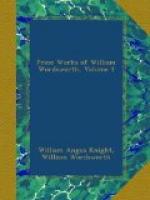476. *_To a Child: written in her Album_. [XIV.]
This quatrain was extempore on observing this image, as I had often done, on the lawn of Rydal Mount. It was first written down in the Album of my god-daughter, Rotha Quillinan.
477. *_Lines written in the Album of the Countess of Lonsdale_. [XV.]
This is a faithful picture of that amiable Lady as she then was. The youthfulness of figure and demeanour and habits, which she retained in almost unprecedented degree, departed a very few years after, and she died without violent disease by gradual decay, before she reached the period of old age. [In pencil—Was she not 70? Mr. J.]
478. The Russian Fugitive. [XVII.]
Peter Henry Bruce, having given in his entertaining Memoirs the substance of this Tale, affirms that, besides the concurring reports of others, he had the story from the lady’s own mouth. The Lady Catherine, mentioned towards the close, is the famous Catherine, then bearing that name as the acknowledged wife of Peter the Great.
479. *_Ibid._
Early in life this story had interested me; and I often thought it would make a pleasing subject for an Opera or musical drama.
XXI. INSCRIPTIONS.
480. (I.) In the grounds of Coleorton these verses are engraved on a stone, placed near the tree, which was thriving and spreading when I saw it in the summer of 1841.
481. (II.) This Niche is in the sandstone rock in the winter-garden at Coleorton, which garden, as has been elsewhere said, was made under our direction out of an old unsightly quarry. While the labourers were at work Mrs. Wordsworth, my sister, and I used to amuse ourselves occasionally in scooping this seat out of the soft stone. It is of the size, with something of the appearance, of a stall in a cathedral. This inscription is not engraven, as the former and the two following are, in the grounds.
482. (VI.) The circumstance alluded to at the conclusion of these verses was told me by Dr. Satterthwaite, who was Incumbent of Boodle, a small town at the foot of Black Combe. He had the particulars from one of the engineers, who was employed in making trigonometrical surveys of that region.
483. (VIII.) Engraven, during my absence in Italy, upon a brass plate inserted in the stone.
484. (IX.) The walk is what we call the far-terrace, beyond the summer-house, at Rydal Mount. The lines were written when we were afraid of being obliged to quit the place to which we were so much attached.
485. (XI.) The monument of ice here spoken of I observed while ascending the middle road of the three ways that lead from Rydal to Grasmere. It was on my right hand, and my eyes were upon it when it fell, as told in these lines.
486. (XII.) Where the second quarry now is, as you pass from Rydal to Grasmere, there was formerly a length of smooth rock that sloped towards the road on the right hand. I used to call it tadpole slope, from having frequently observed there the water bubbles gliding under the ice, exactly in the shape of that creature.




